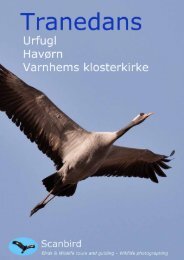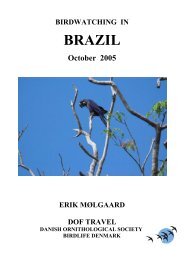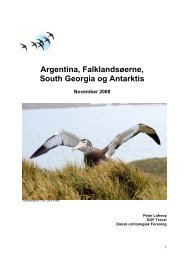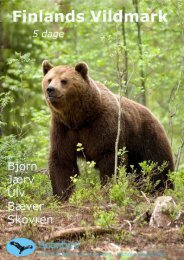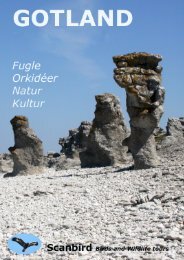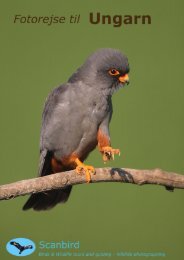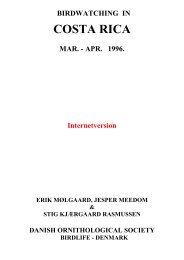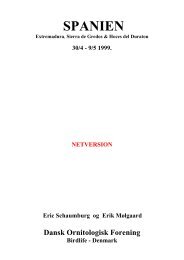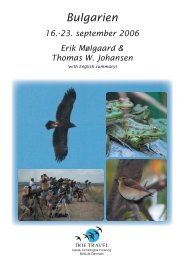Birding Southern Sweden (large PDF file (5 MB) - Tåkerns Fältstation
Birding Southern Sweden (large PDF file (5 MB) - Tåkerns Fältstation
Birding Southern Sweden (large PDF file (5 MB) - Tåkerns Fältstation
Create successful ePaper yourself
Turn your PDF publications into a flip-book with our unique Google optimized e-Paper software.
Hornborgasjön<br />
Hornborgasjön (Lake Hornborga) lies between the <strong>large</strong> lakes<br />
Vänern and Vättern as a <strong>large</strong> depression in the landscape. The<br />
first discernible sign of the lake’s origin began 10,000 years ago,<br />
when the inland ice sheet retreated. The area then consisted of a<br />
<strong>large</strong> shallow bay of the West Coast Sea. The area became separated<br />
from the sea as the land lifted following the ice retreat,<br />
and developed as a freshwater lake.<br />
Hornborgasjön is one of <strong>Sweden</strong>’s <strong>large</strong>st and most valuable<br />
bird lakes. At the end of the 19th century it was recognised to<br />
be north Europe’s most distinguished bird lake and an important<br />
lake in the chain of wetlands that birds use on their migrations<br />
during both spring and autumn. The lake then had a maximum<br />
depth of 2m and had 3000ha of open water surface. After<br />
reductions of lake level from the beginning of the 19th century<br />
until 1930, the lake became transformed into a marsh with<br />
21km of canals that carried water through the former lake.<br />
After pressure from wildlife enthusiasts, the government requested<br />
that Naturvårdsverket should carry out a restoration of<br />
the lake, during the years 1988–1995, in order to regain the<br />
lake’s value as a bird lake. A dam with water regulation was built<br />
at the lake’s outlet and the water level raised by an average of<br />
85cm. Today the lake has a maximum depth of 1.5m and an<br />
average depth of 0.9m. The lake consists of a mosaic of open<br />
water, reed and bush areas, together with shore meadows with a<br />
total wetland area of 3300ha.<br />
The restoration of the lake is in a class of its own as <strong>Sweden</strong>’s<br />
<strong>large</strong>st single nature protection project and has created the prerequisites<br />
for the return or increase of many wetland bird species.<br />
In total 280 species have been recorded at the lake, of which<br />
Up to 10,000 Cranes can be seen in spring.<br />
130 breed regularly in the nature reserve. Of these, 50 are confined<br />
to wetlands, including all of <strong>Sweden</strong>’s five species of grebe.<br />
Marsh Harriers, Great Bitterns and Great Reed Warblers breed<br />
in the lake’s reeds and reed mosaic. Nearly 10,000 pairs of Blackheaded<br />
Gull and 40 pairs of Black Tern breed on the lake’s floating<br />
islands. 100 pairs of Black-necked Grebe and tens of pairs<br />
of Horned Grebe breed in connection with the Black-headed<br />
Gull colony. Along the lake’s cultivated shores and meadows<br />
breed, among others, Spotted Crake, Shoveler, Garganey, Gadwall<br />
and Ruff. In the lake’s bush areas are nests of Penduline<br />
Tits. Osprey and White-tailed Eagles also breed in the region.<br />
Thrush Nightingale, River Warbler, Corncrake, Grasshopper<br />
Warbler and Rosefinch occur adjacent to the lake. Large numbers<br />
of ducks and waders rest in spring and autumn. The lake’s<br />
characteristic bird is the Crane, which rests there both autumn<br />
JAN TÖVE ⁄ N<br />
16



